Contemporary Developments in Employment Relations: A Detailed Report
VerifiedAdded on 2023/03/29
|20
|5114
|412
Report
AI Summary
This report provides a comprehensive analysis of contemporary developments in employment relations, focusing on the indeterminate nature of employment relations, contrasting unitarist and pluralist approaches, and assessing various factors impacting these relations. It describes essential features of employment contracts, identifies and analyzes key sources of UK and EU employment law, and explains main developments in individual employment law, including the impact of the Coronavirus Act 2020 and revisions to sick pay provisions. The report further explores differences in employee involvement, participation, and partnership, comparing union and non-union forms of employee representation, and assessing the link between employee voice and organizational performance. Finally, it distinguishes between conflict and misbehavior, assesses contemporary trends in conflict types and industrial sanctions, and explains the requirements for advising managers in effective grievance handling.

Running head: CONTEMPORARY DEVELOPMENTS IN EMPLOYMENT RELATIONS
Contemporary Developments in Employment Relations
Name of the Student
Name of the University
Author Note
Contemporary Developments in Employment Relations
Name of the Student
Name of the University
Author Note
Paraphrase This Document
Need a fresh take? Get an instant paraphrase of this document with our AI Paraphraser
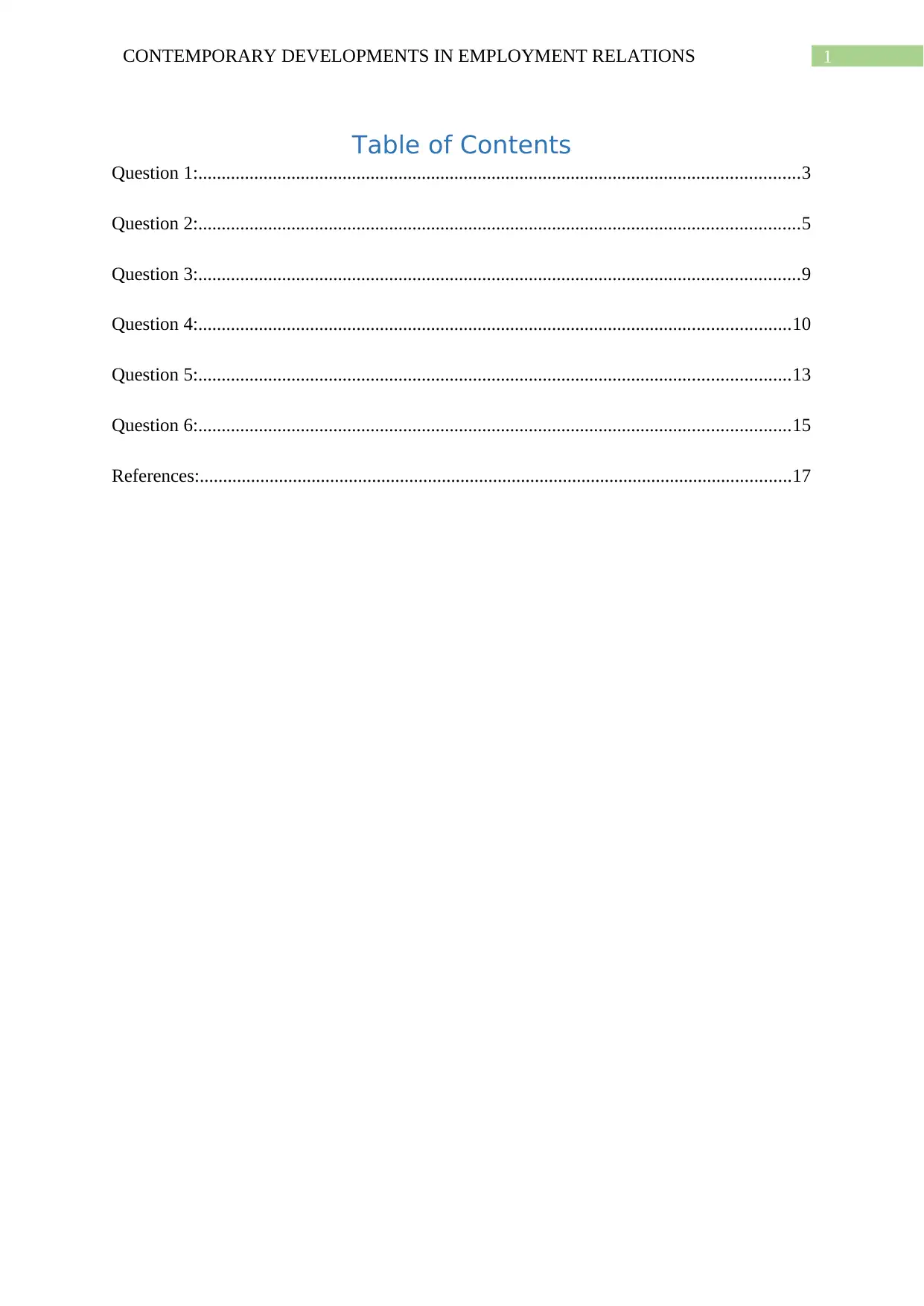
1CONTEMPORARY DEVELOPMENTS IN EMPLOYMENT RELATIONS
Table of Contents
Question 1:.................................................................................................................................3
Question 2:.................................................................................................................................5
Question 3:.................................................................................................................................9
Question 4:...............................................................................................................................10
Question 5:...............................................................................................................................13
Question 6:...............................................................................................................................15
References:...............................................................................................................................17
Table of Contents
Question 1:.................................................................................................................................3
Question 2:.................................................................................................................................5
Question 3:.................................................................................................................................9
Question 4:...............................................................................................................................10
Question 5:...............................................................................................................................13
Question 6:...............................................................................................................................15
References:...............................................................................................................................17
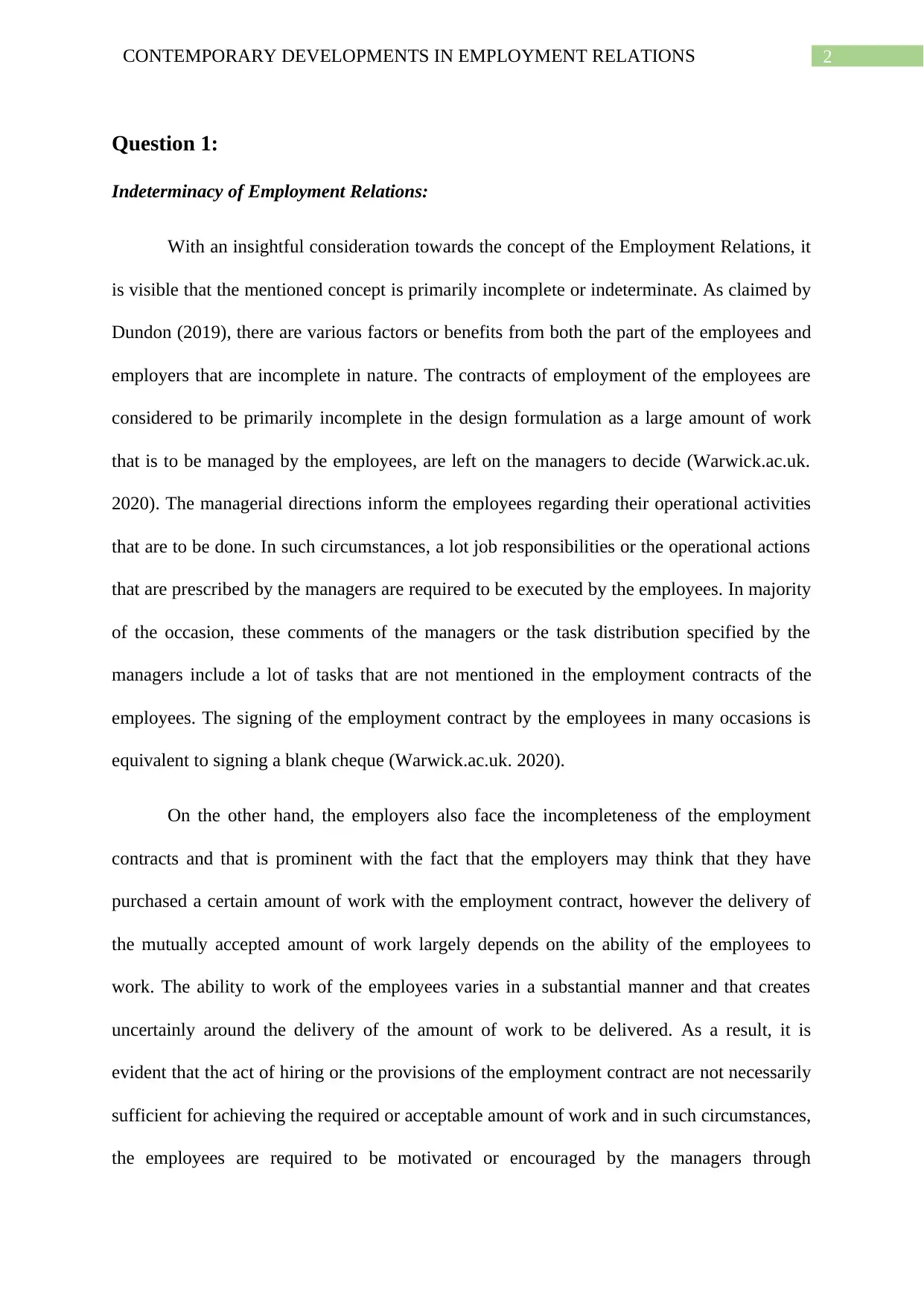
2CONTEMPORARY DEVELOPMENTS IN EMPLOYMENT RELATIONS
Question 1:
Indeterminacy of Employment Relations:
With an insightful consideration towards the concept of the Employment Relations, it
is visible that the mentioned concept is primarily incomplete or indeterminate. As claimed by
Dundon (2019), there are various factors or benefits from both the part of the employees and
employers that are incomplete in nature. The contracts of employment of the employees are
considered to be primarily incomplete in the design formulation as a large amount of work
that is to be managed by the employees, are left on the managers to decide (Warwick.ac.uk.
2020). The managerial directions inform the employees regarding their operational activities
that are to be done. In such circumstances, a lot job responsibilities or the operational actions
that are prescribed by the managers are required to be executed by the employees. In majority
of the occasion, these comments of the managers or the task distribution specified by the
managers include a lot of tasks that are not mentioned in the employment contracts of the
employees. The signing of the employment contract by the employees in many occasions is
equivalent to signing a blank cheque (Warwick.ac.uk. 2020).
On the other hand, the employers also face the incompleteness of the employment
contracts and that is prominent with the fact that the employers may think that they have
purchased a certain amount of work with the employment contract, however the delivery of
the mutually accepted amount of work largely depends on the ability of the employees to
work. The ability to work of the employees varies in a substantial manner and that creates
uncertainly around the delivery of the amount of work to be delivered. As a result, it is
evident that the act of hiring or the provisions of the employment contract are not necessarily
sufficient for achieving the required or acceptable amount of work and in such circumstances,
the employees are required to be motivated or encouraged by the managers through
Question 1:
Indeterminacy of Employment Relations:
With an insightful consideration towards the concept of the Employment Relations, it
is visible that the mentioned concept is primarily incomplete or indeterminate. As claimed by
Dundon (2019), there are various factors or benefits from both the part of the employees and
employers that are incomplete in nature. The contracts of employment of the employees are
considered to be primarily incomplete in the design formulation as a large amount of work
that is to be managed by the employees, are left on the managers to decide (Warwick.ac.uk.
2020). The managerial directions inform the employees regarding their operational activities
that are to be done. In such circumstances, a lot job responsibilities or the operational actions
that are prescribed by the managers are required to be executed by the employees. In majority
of the occasion, these comments of the managers or the task distribution specified by the
managers include a lot of tasks that are not mentioned in the employment contracts of the
employees. The signing of the employment contract by the employees in many occasions is
equivalent to signing a blank cheque (Warwick.ac.uk. 2020).
On the other hand, the employers also face the incompleteness of the employment
contracts and that is prominent with the fact that the employers may think that they have
purchased a certain amount of work with the employment contract, however the delivery of
the mutually accepted amount of work largely depends on the ability of the employees to
work. The ability to work of the employees varies in a substantial manner and that creates
uncertainly around the delivery of the amount of work to be delivered. As a result, it is
evident that the act of hiring or the provisions of the employment contract are not necessarily
sufficient for achieving the required or acceptable amount of work and in such circumstances,
the employees are required to be motivated or encouraged by the managers through
⊘ This is a preview!⊘
Do you want full access?
Subscribe today to unlock all pages.

Trusted by 1+ million students worldwide

3CONTEMPORARY DEVELOPMENTS IN EMPLOYMENT RELATIONS
interventions such as the pride, promotion, threat, competition, discipline, money or loyalty
(Morris, Farrell and Reed 2016). As a result, the nature of indeterminacy of the employment
relations is pretty prominent.
Factors affecting the Employment Relations:
There are various factors affecting the employment relations in the modern world of
trade and they are classified into two broad groups which are the internal and external factors.
Two important internal factors that affect the employment relations are the workplace culture
along with the monetary compensation characteristics and the rewards. As claimed by Kim
and Bae (2017), a positive and productive workplace culture has the possibility of creating a
high performance working environment which has greater potential for accomplishing the
mission and vision of the companies. On the other hand, an inappropriate workplace culture
has the possibility to lead the company towards the increasing conflicts and disruptions in
work. Jacoby (2018), highlighted that the attractive compensation plan and rewards are
crucial for the organizations when it comes motivate and encourage their employees for the
desired enrichment of their performances. On the other hand, the inaccurate formation of the
compensation plan and rewards plan has detrimental consequences for the companies in the
form of the high employee turnover along with a dissatisfied and demotivated workforce.
Two important external factors are the competitors and the government legislations.
The competitor organizations have the possibility of offering higher job roles, higher salaries
and attractive benefits for acquiring the talented employees and the threat of the same has
certainly tremendous impact on the employment relations of any particular company. Along
with that, the frequently changing employment legislations have an important say on the
formulation of the employment relations in the modern world of trade and that is pretty
prominent with the fact that the government legislation influences the formation of the
interventions such as the pride, promotion, threat, competition, discipline, money or loyalty
(Morris, Farrell and Reed 2016). As a result, the nature of indeterminacy of the employment
relations is pretty prominent.
Factors affecting the Employment Relations:
There are various factors affecting the employment relations in the modern world of
trade and they are classified into two broad groups which are the internal and external factors.
Two important internal factors that affect the employment relations are the workplace culture
along with the monetary compensation characteristics and the rewards. As claimed by Kim
and Bae (2017), a positive and productive workplace culture has the possibility of creating a
high performance working environment which has greater potential for accomplishing the
mission and vision of the companies. On the other hand, an inappropriate workplace culture
has the possibility to lead the company towards the increasing conflicts and disruptions in
work. Jacoby (2018), highlighted that the attractive compensation plan and rewards are
crucial for the organizations when it comes motivate and encourage their employees for the
desired enrichment of their performances. On the other hand, the inaccurate formation of the
compensation plan and rewards plan has detrimental consequences for the companies in the
form of the high employee turnover along with a dissatisfied and demotivated workforce.
Two important external factors are the competitors and the government legislations.
The competitor organizations have the possibility of offering higher job roles, higher salaries
and attractive benefits for acquiring the talented employees and the threat of the same has
certainly tremendous impact on the employment relations of any particular company. Along
with that, the frequently changing employment legislations have an important say on the
formulation of the employment relations in the modern world of trade and that is pretty
prominent with the fact that the government legislation influences the formation of the
Paraphrase This Document
Need a fresh take? Get an instant paraphrase of this document with our AI Paraphraser
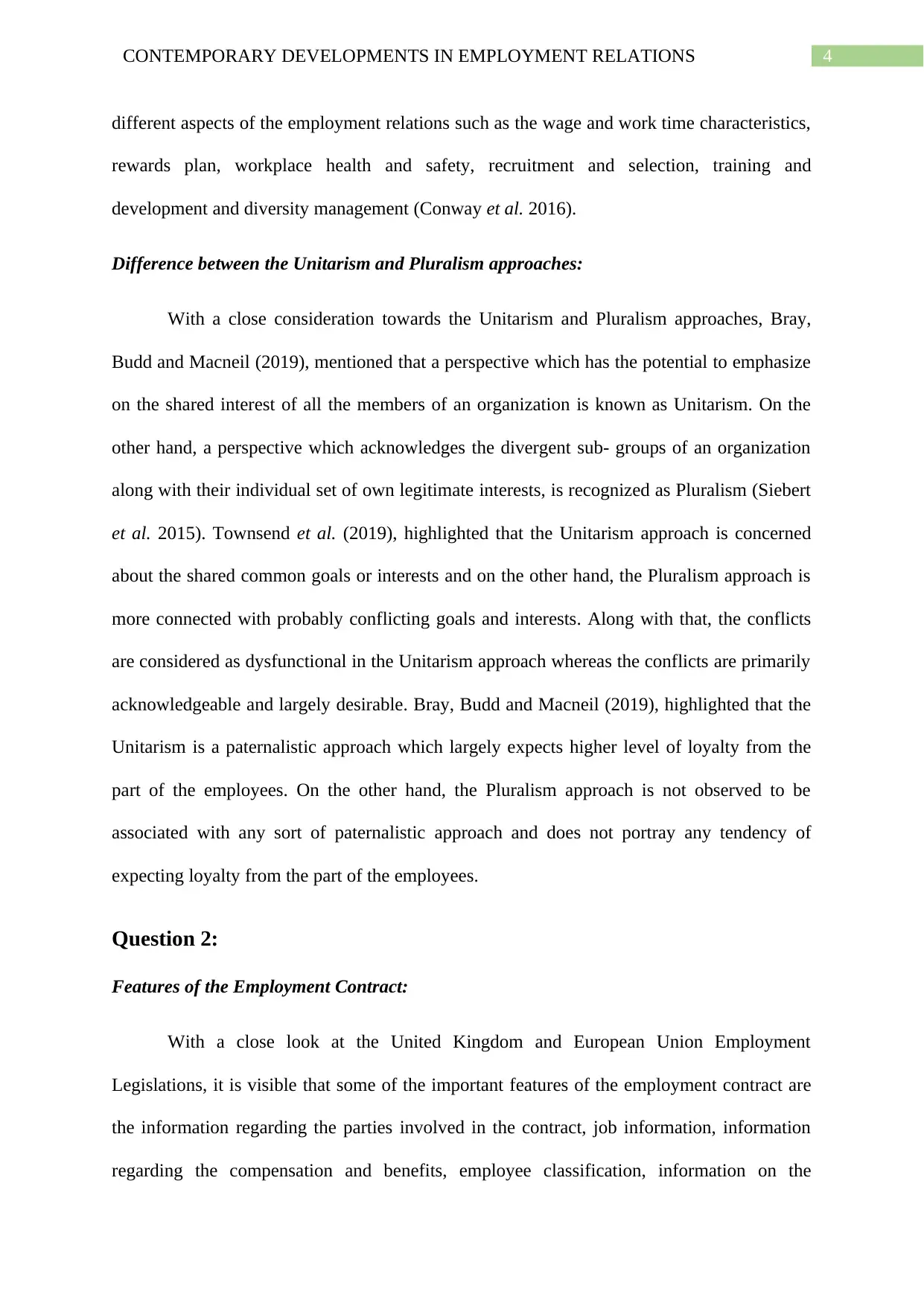
4CONTEMPORARY DEVELOPMENTS IN EMPLOYMENT RELATIONS
different aspects of the employment relations such as the wage and work time characteristics,
rewards plan, workplace health and safety, recruitment and selection, training and
development and diversity management (Conway et al. 2016).
Difference between the Unitarism and Pluralism approaches:
With a close consideration towards the Unitarism and Pluralism approaches, Bray,
Budd and Macneil (2019), mentioned that a perspective which has the potential to emphasize
on the shared interest of all the members of an organization is known as Unitarism. On the
other hand, a perspective which acknowledges the divergent sub- groups of an organization
along with their individual set of own legitimate interests, is recognized as Pluralism (Siebert
et al. 2015). Townsend et al. (2019), highlighted that the Unitarism approach is concerned
about the shared common goals or interests and on the other hand, the Pluralism approach is
more connected with probably conflicting goals and interests. Along with that, the conflicts
are considered as dysfunctional in the Unitarism approach whereas the conflicts are primarily
acknowledgeable and largely desirable. Bray, Budd and Macneil (2019), highlighted that the
Unitarism is a paternalistic approach which largely expects higher level of loyalty from the
part of the employees. On the other hand, the Pluralism approach is not observed to be
associated with any sort of paternalistic approach and does not portray any tendency of
expecting loyalty from the part of the employees.
Question 2:
Features of the Employment Contract:
With a close look at the United Kingdom and European Union Employment
Legislations, it is visible that some of the important features of the employment contract are
the information regarding the parties involved in the contract, job information, information
regarding the compensation and benefits, employee classification, information on the
different aspects of the employment relations such as the wage and work time characteristics,
rewards plan, workplace health and safety, recruitment and selection, training and
development and diversity management (Conway et al. 2016).
Difference between the Unitarism and Pluralism approaches:
With a close consideration towards the Unitarism and Pluralism approaches, Bray,
Budd and Macneil (2019), mentioned that a perspective which has the potential to emphasize
on the shared interest of all the members of an organization is known as Unitarism. On the
other hand, a perspective which acknowledges the divergent sub- groups of an organization
along with their individual set of own legitimate interests, is recognized as Pluralism (Siebert
et al. 2015). Townsend et al. (2019), highlighted that the Unitarism approach is concerned
about the shared common goals or interests and on the other hand, the Pluralism approach is
more connected with probably conflicting goals and interests. Along with that, the conflicts
are considered as dysfunctional in the Unitarism approach whereas the conflicts are primarily
acknowledgeable and largely desirable. Bray, Budd and Macneil (2019), highlighted that the
Unitarism is a paternalistic approach which largely expects higher level of loyalty from the
part of the employees. On the other hand, the Pluralism approach is not observed to be
associated with any sort of paternalistic approach and does not portray any tendency of
expecting loyalty from the part of the employees.
Question 2:
Features of the Employment Contract:
With a close look at the United Kingdom and European Union Employment
Legislations, it is visible that some of the important features of the employment contract are
the information regarding the parties involved in the contract, job information, information
regarding the compensation and benefits, employee classification, information on the
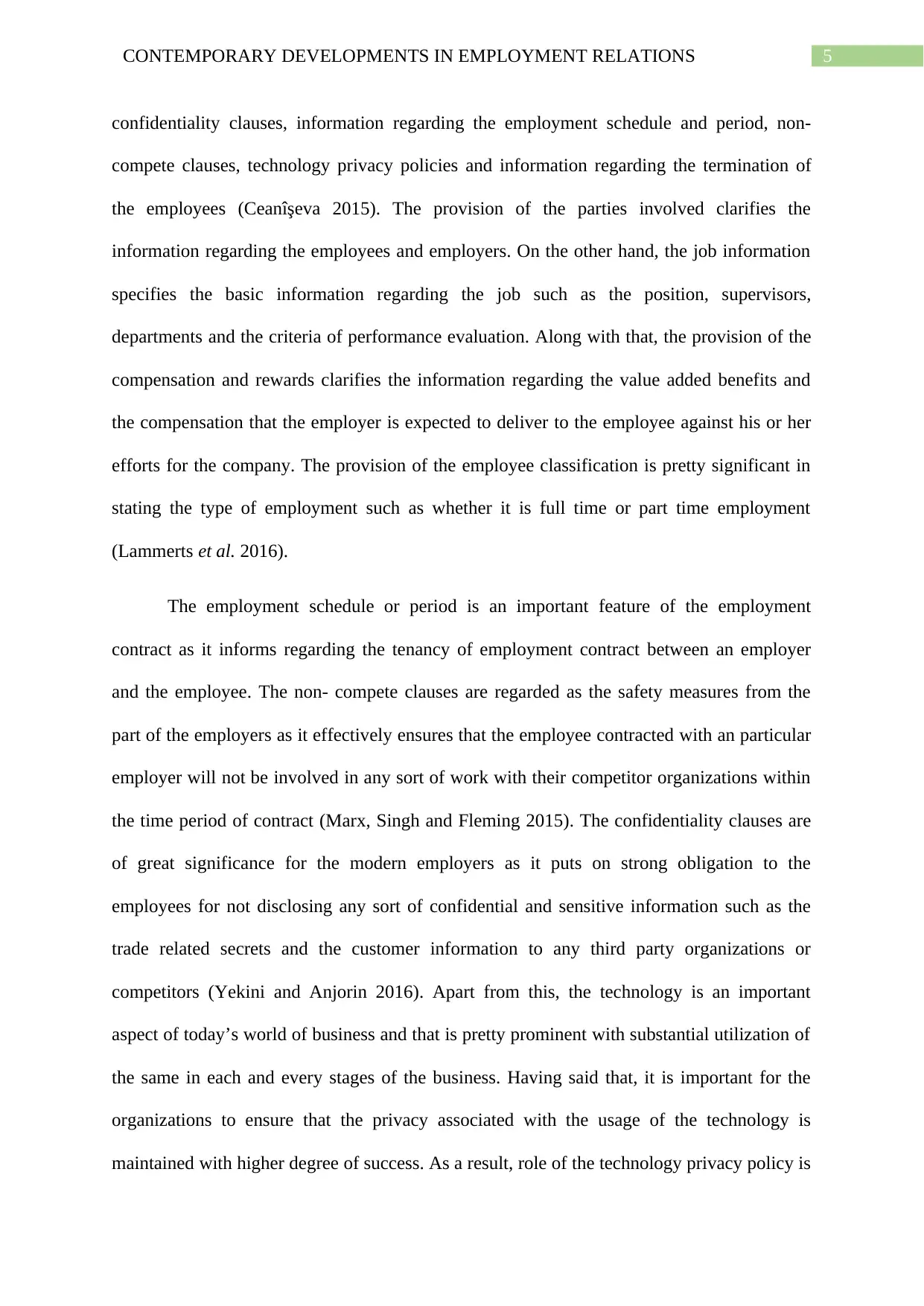
5CONTEMPORARY DEVELOPMENTS IN EMPLOYMENT RELATIONS
confidentiality clauses, information regarding the employment schedule and period, non-
compete clauses, technology privacy policies and information regarding the termination of
the employees (Ceanîşeva 2015). The provision of the parties involved clarifies the
information regarding the employees and employers. On the other hand, the job information
specifies the basic information regarding the job such as the position, supervisors,
departments and the criteria of performance evaluation. Along with that, the provision of the
compensation and rewards clarifies the information regarding the value added benefits and
the compensation that the employer is expected to deliver to the employee against his or her
efforts for the company. The provision of the employee classification is pretty significant in
stating the type of employment such as whether it is full time or part time employment
(Lammerts et al. 2016).
The employment schedule or period is an important feature of the employment
contract as it informs regarding the tenancy of employment contract between an employer
and the employee. The non- compete clauses are regarded as the safety measures from the
part of the employers as it effectively ensures that the employee contracted with an particular
employer will not be involved in any sort of work with their competitor organizations within
the time period of contract (Marx, Singh and Fleming 2015). The confidentiality clauses are
of great significance for the modern employers as it puts on strong obligation to the
employees for not disclosing any sort of confidential and sensitive information such as the
trade related secrets and the customer information to any third party organizations or
competitors (Yekini and Anjorin 2016). Apart from this, the technology is an important
aspect of today’s world of business and that is pretty prominent with substantial utilization of
the same in each and every stages of the business. Having said that, it is important for the
organizations to ensure that the privacy associated with the usage of the technology is
maintained with higher degree of success. As a result, role of the technology privacy policy is
confidentiality clauses, information regarding the employment schedule and period, non-
compete clauses, technology privacy policies and information regarding the termination of
the employees (Ceanîşeva 2015). The provision of the parties involved clarifies the
information regarding the employees and employers. On the other hand, the job information
specifies the basic information regarding the job such as the position, supervisors,
departments and the criteria of performance evaluation. Along with that, the provision of the
compensation and rewards clarifies the information regarding the value added benefits and
the compensation that the employer is expected to deliver to the employee against his or her
efforts for the company. The provision of the employee classification is pretty significant in
stating the type of employment such as whether it is full time or part time employment
(Lammerts et al. 2016).
The employment schedule or period is an important feature of the employment
contract as it informs regarding the tenancy of employment contract between an employer
and the employee. The non- compete clauses are regarded as the safety measures from the
part of the employers as it effectively ensures that the employee contracted with an particular
employer will not be involved in any sort of work with their competitor organizations within
the time period of contract (Marx, Singh and Fleming 2015). The confidentiality clauses are
of great significance for the modern employers as it puts on strong obligation to the
employees for not disclosing any sort of confidential and sensitive information such as the
trade related secrets and the customer information to any third party organizations or
competitors (Yekini and Anjorin 2016). Apart from this, the technology is an important
aspect of today’s world of business and that is pretty prominent with substantial utilization of
the same in each and every stages of the business. Having said that, it is important for the
organizations to ensure that the privacy associated with the usage of the technology is
maintained with higher degree of success. As a result, role of the technology privacy policy is
⊘ This is a preview!⊘
Do you want full access?
Subscribe today to unlock all pages.

Trusted by 1+ million students worldwide

6CONTEMPORARY DEVELOPMENTS IN EMPLOYMENT RELATIONS
substantially important in the management of the employment relations. The final feature
which is the termination of contract informs regarding the facets of termination, process of
termination along with the notice period of termination (Gillan and Nguyen 2016). The legal
clauses ensures that the employees and the employers are bound to comply with the
legislations and the appropriate compliance ensures the appropriate management of trust and
commitment amongst the employees and the employers in the organizational context.
Sources of Employment Legislation and Development:
With a precise consideration towards the main sources of the United Kingdom and
European Union employment relations legislations, the significant presence of the
Employment Rights Act 1996, National Minimum Wage Act 1998, Employment Relations
Act 1999, The Maternity and Parental Leave etc. Regulations 1999, Part-Time Workers
(Prevention of Less Favourable Treatment) Regulations 2000, Agency Workers Regulations
2010 and Transfer of Undertakings (Protection of Employment) Regulations 2006 is notably
visible (Legislation.gov.uk. 2020). Along with these sources, some of the important sources
that are shaping the dynamics of the employment relations in United Kingdome are the
Bribery Act 2010, Working Time Regulations 1998 and Data Protection Act 2018
(Legislation.gov.uk. 2020). Considering the European Union labour legislation, it is
understandable that the main source of employment legislations are primarily divided into
three clusters which are conditions of employment, protection of the personal data along with
informing and consulting the workers (Nibusinessinfo.co.uk. 2020). Two important
institutions for the regulation of the employment legislations are observed to be the European
Commission and ACAS (Acas.org.uk. 2020). With a close look at the European Union
directives and United Kingdom legislations, a massive development in the Employment
legislations of the nation is observed to be the Coronavirus Act 2020 (Ec.europa.eu. 2020).
substantially important in the management of the employment relations. The final feature
which is the termination of contract informs regarding the facets of termination, process of
termination along with the notice period of termination (Gillan and Nguyen 2016). The legal
clauses ensures that the employees and the employers are bound to comply with the
legislations and the appropriate compliance ensures the appropriate management of trust and
commitment amongst the employees and the employers in the organizational context.
Sources of Employment Legislation and Development:
With a precise consideration towards the main sources of the United Kingdom and
European Union employment relations legislations, the significant presence of the
Employment Rights Act 1996, National Minimum Wage Act 1998, Employment Relations
Act 1999, The Maternity and Parental Leave etc. Regulations 1999, Part-Time Workers
(Prevention of Less Favourable Treatment) Regulations 2000, Agency Workers Regulations
2010 and Transfer of Undertakings (Protection of Employment) Regulations 2006 is notably
visible (Legislation.gov.uk. 2020). Along with these sources, some of the important sources
that are shaping the dynamics of the employment relations in United Kingdome are the
Bribery Act 2010, Working Time Regulations 1998 and Data Protection Act 2018
(Legislation.gov.uk. 2020). Considering the European Union labour legislation, it is
understandable that the main source of employment legislations are primarily divided into
three clusters which are conditions of employment, protection of the personal data along with
informing and consulting the workers (Nibusinessinfo.co.uk. 2020). Two important
institutions for the regulation of the employment legislations are observed to be the European
Commission and ACAS (Acas.org.uk. 2020). With a close look at the European Union
directives and United Kingdom legislations, a massive development in the Employment
legislations of the nation is observed to be the Coronavirus Act 2020 (Ec.europa.eu. 2020).
Paraphrase This Document
Need a fresh take? Get an instant paraphrase of this document with our AI Paraphraser
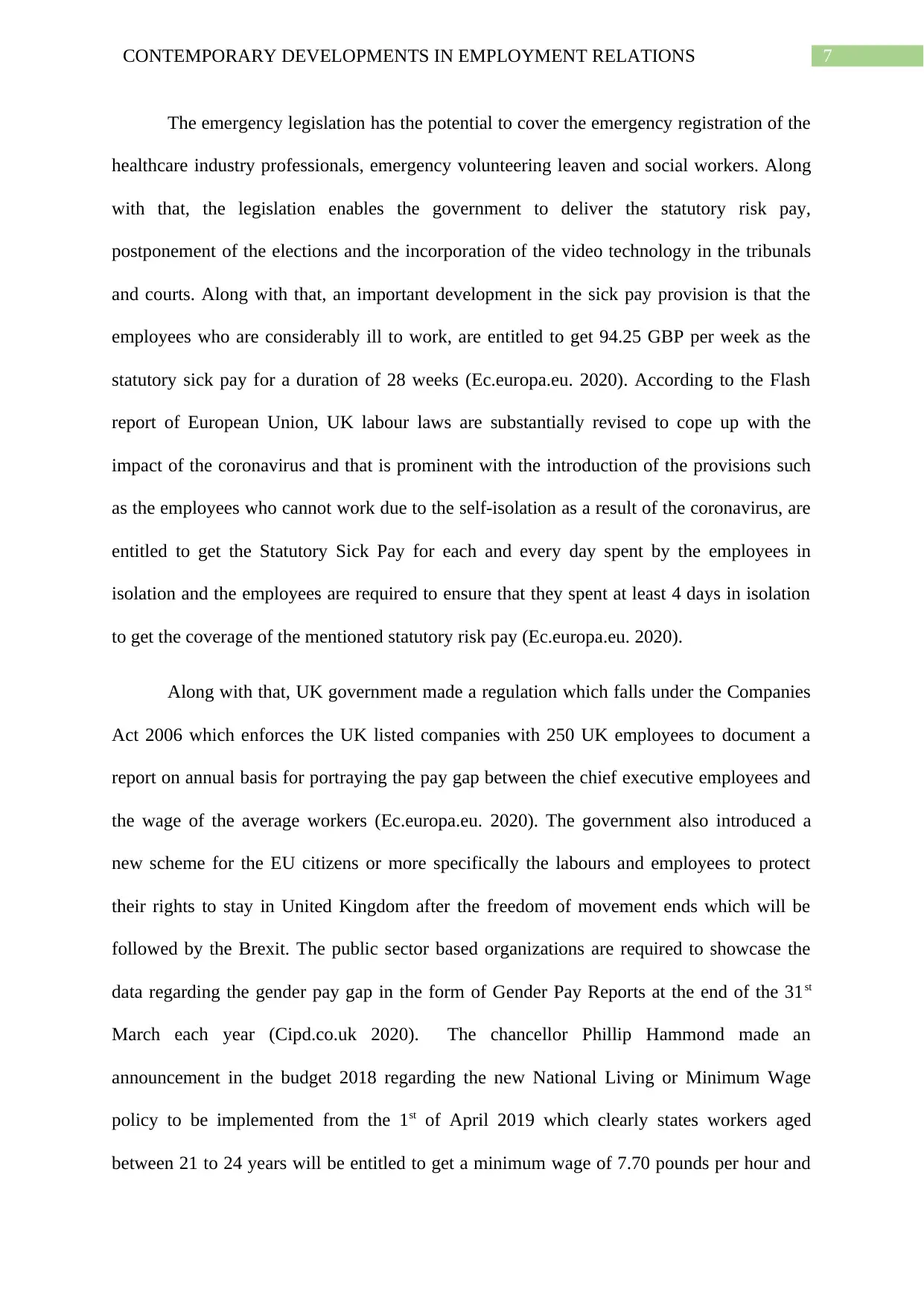
7CONTEMPORARY DEVELOPMENTS IN EMPLOYMENT RELATIONS
The emergency legislation has the potential to cover the emergency registration of the
healthcare industry professionals, emergency volunteering leaven and social workers. Along
with that, the legislation enables the government to deliver the statutory risk pay,
postponement of the elections and the incorporation of the video technology in the tribunals
and courts. Along with that, an important development in the sick pay provision is that the
employees who are considerably ill to work, are entitled to get 94.25 GBP per week as the
statutory sick pay for a duration of 28 weeks (Ec.europa.eu. 2020). According to the Flash
report of European Union, UK labour laws are substantially revised to cope up with the
impact of the coronavirus and that is prominent with the introduction of the provisions such
as the employees who cannot work due to the self-isolation as a result of the coronavirus, are
entitled to get the Statutory Sick Pay for each and every day spent by the employees in
isolation and the employees are required to ensure that they spent at least 4 days in isolation
to get the coverage of the mentioned statutory risk pay (Ec.europa.eu. 2020).
Along with that, UK government made a regulation which falls under the Companies
Act 2006 which enforces the UK listed companies with 250 UK employees to document a
report on annual basis for portraying the pay gap between the chief executive employees and
the wage of the average workers (Ec.europa.eu. 2020). The government also introduced a
new scheme for the EU citizens or more specifically the labours and employees to protect
their rights to stay in United Kingdom after the freedom of movement ends which will be
followed by the Brexit. The public sector based organizations are required to showcase the
data regarding the gender pay gap in the form of Gender Pay Reports at the end of the 31st
March each year (Cipd.co.uk 2020). The chancellor Phillip Hammond made an
announcement in the budget 2018 regarding the new National Living or Minimum Wage
policy to be implemented from the 1st of April 2019 which clearly states workers aged
between 21 to 24 years will be entitled to get a minimum wage of 7.70 pounds per hour and
The emergency legislation has the potential to cover the emergency registration of the
healthcare industry professionals, emergency volunteering leaven and social workers. Along
with that, the legislation enables the government to deliver the statutory risk pay,
postponement of the elections and the incorporation of the video technology in the tribunals
and courts. Along with that, an important development in the sick pay provision is that the
employees who are considerably ill to work, are entitled to get 94.25 GBP per week as the
statutory sick pay for a duration of 28 weeks (Ec.europa.eu. 2020). According to the Flash
report of European Union, UK labour laws are substantially revised to cope up with the
impact of the coronavirus and that is prominent with the introduction of the provisions such
as the employees who cannot work due to the self-isolation as a result of the coronavirus, are
entitled to get the Statutory Sick Pay for each and every day spent by the employees in
isolation and the employees are required to ensure that they spent at least 4 days in isolation
to get the coverage of the mentioned statutory risk pay (Ec.europa.eu. 2020).
Along with that, UK government made a regulation which falls under the Companies
Act 2006 which enforces the UK listed companies with 250 UK employees to document a
report on annual basis for portraying the pay gap between the chief executive employees and
the wage of the average workers (Ec.europa.eu. 2020). The government also introduced a
new scheme for the EU citizens or more specifically the labours and employees to protect
their rights to stay in United Kingdom after the freedom of movement ends which will be
followed by the Brexit. The public sector based organizations are required to showcase the
data regarding the gender pay gap in the form of Gender Pay Reports at the end of the 31st
March each year (Cipd.co.uk 2020). The chancellor Phillip Hammond made an
announcement in the budget 2018 regarding the new National Living or Minimum Wage
policy to be implemented from the 1st of April 2019 which clearly states workers aged
between 21 to 24 years will be entitled to get a minimum wage of 7.70 pounds per hour and
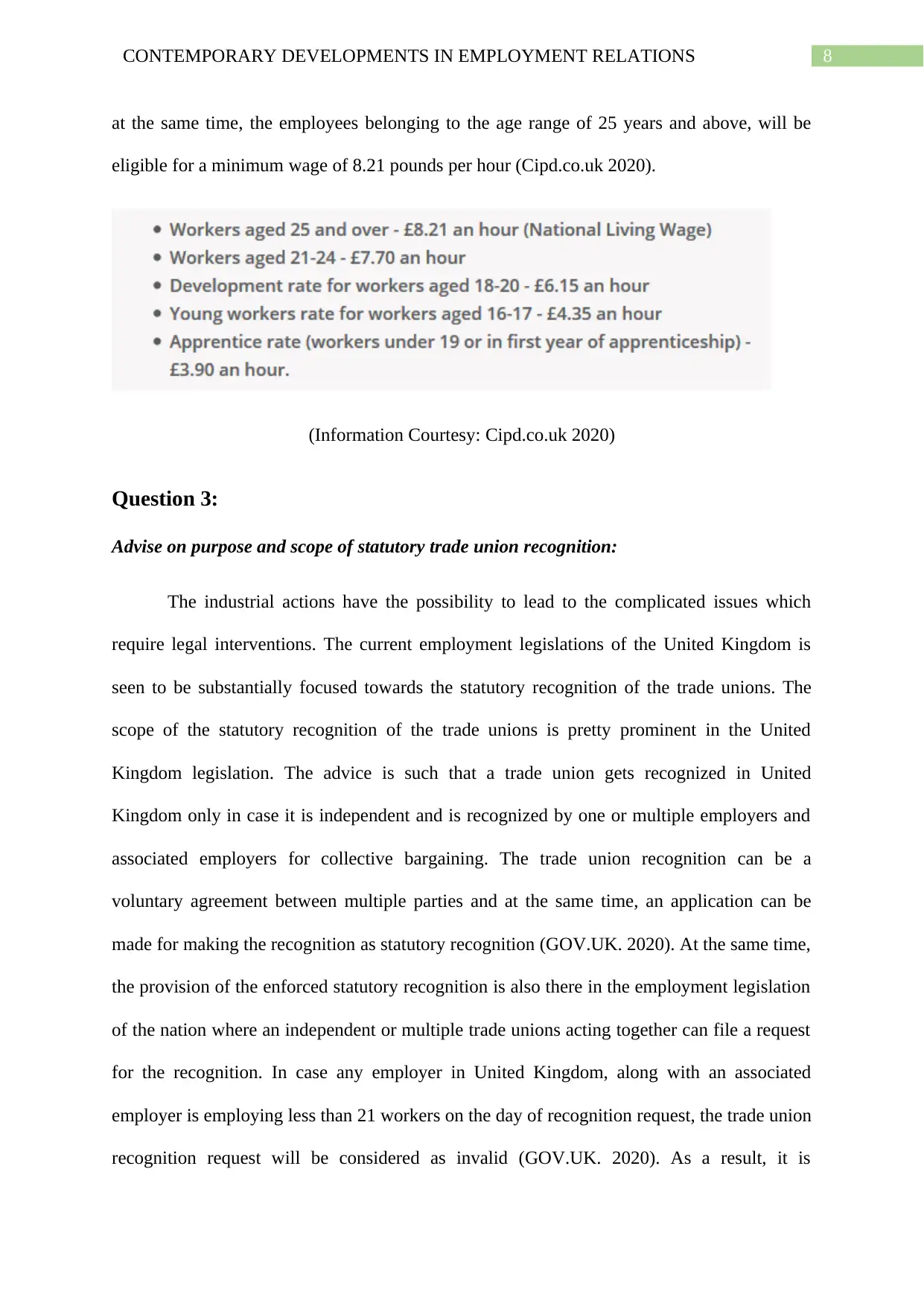
8CONTEMPORARY DEVELOPMENTS IN EMPLOYMENT RELATIONS
at the same time, the employees belonging to the age range of 25 years and above, will be
eligible for a minimum wage of 8.21 pounds per hour (Cipd.co.uk 2020).
(Information Courtesy: Cipd.co.uk 2020)
Question 3:
Advise on purpose and scope of statutory trade union recognition:
The industrial actions have the possibility to lead to the complicated issues which
require legal interventions. The current employment legislations of the United Kingdom is
seen to be substantially focused towards the statutory recognition of the trade unions. The
scope of the statutory recognition of the trade unions is pretty prominent in the United
Kingdom legislation. The advice is such that a trade union gets recognized in United
Kingdom only in case it is independent and is recognized by one or multiple employers and
associated employers for collective bargaining. The trade union recognition can be a
voluntary agreement between multiple parties and at the same time, an application can be
made for making the recognition as statutory recognition (GOV.UK. 2020). At the same time,
the provision of the enforced statutory recognition is also there in the employment legislation
of the nation where an independent or multiple trade unions acting together can file a request
for the recognition. In case any employer in United Kingdom, along with an associated
employer is employing less than 21 workers on the day of recognition request, the trade union
recognition request will be considered as invalid (GOV.UK. 2020). As a result, it is
at the same time, the employees belonging to the age range of 25 years and above, will be
eligible for a minimum wage of 8.21 pounds per hour (Cipd.co.uk 2020).
(Information Courtesy: Cipd.co.uk 2020)
Question 3:
Advise on purpose and scope of statutory trade union recognition:
The industrial actions have the possibility to lead to the complicated issues which
require legal interventions. The current employment legislations of the United Kingdom is
seen to be substantially focused towards the statutory recognition of the trade unions. The
scope of the statutory recognition of the trade unions is pretty prominent in the United
Kingdom legislation. The advice is such that a trade union gets recognized in United
Kingdom only in case it is independent and is recognized by one or multiple employers and
associated employers for collective bargaining. The trade union recognition can be a
voluntary agreement between multiple parties and at the same time, an application can be
made for making the recognition as statutory recognition (GOV.UK. 2020). At the same time,
the provision of the enforced statutory recognition is also there in the employment legislation
of the nation where an independent or multiple trade unions acting together can file a request
for the recognition. In case any employer in United Kingdom, along with an associated
employer is employing less than 21 workers on the day of recognition request, the trade union
recognition request will be considered as invalid (GOV.UK. 2020). As a result, it is
⊘ This is a preview!⊘
Do you want full access?
Subscribe today to unlock all pages.

Trusted by 1+ million students worldwide

9CONTEMPORARY DEVELOPMENTS IN EMPLOYMENT RELATIONS
understandable that the United Kingdom labour and employment legislation is able to ensure
that the statutory recognition of the trade union for the employers with less than 21
employees is a voluntary act. The consequences of these trade unions are primarily the
appropriate establishment of law in the organizational context as the trade union
representatives holds a good share of bargaining power and at the same time, they speak up
for the employees that they represent in from of the employers and ensures that the best
interest of the employees and employers is maintained in an appropriate manner. Along with
that, the statutory derecognition of a non- independent trade union can take place only in case
an “application under part VI of schedule A1” is signed and completed by an employee or a
group of employee (GOV.UK. 2020). The employee or the group of employees can request
for a secret ballot of workers to investigate whether they want the union to be derecognized
and at the employee or the group of employees are required to provide evidence in the form
of letters supporting the application and workplace surveys for the following:
It is to be proved that at least 10% of the employees in the bargaining unit are wanting
the union to be derecognized (GOV.UK. 2020).
It is also to be proved that majority of the workers in the bargaining unit are more
inclined towards favouring a conclusion to bargaining arrangements (GOV.UK.
2020).
Question 4:
Key Terms used in the Employee Involvement and Participation:
The definition of the employee involvement is such that it refers to the processes and
structures that effectively invites or allows the workers to systematically put forward their
input into the actions or decisions that have the potential to affect their own their work. The
employee participation is the action which voluntarily or non- voluntarily ensures that the
understandable that the United Kingdom labour and employment legislation is able to ensure
that the statutory recognition of the trade union for the employers with less than 21
employees is a voluntary act. The consequences of these trade unions are primarily the
appropriate establishment of law in the organizational context as the trade union
representatives holds a good share of bargaining power and at the same time, they speak up
for the employees that they represent in from of the employers and ensures that the best
interest of the employees and employers is maintained in an appropriate manner. Along with
that, the statutory derecognition of a non- independent trade union can take place only in case
an “application under part VI of schedule A1” is signed and completed by an employee or a
group of employee (GOV.UK. 2020). The employee or the group of employees can request
for a secret ballot of workers to investigate whether they want the union to be derecognized
and at the employee or the group of employees are required to provide evidence in the form
of letters supporting the application and workplace surveys for the following:
It is to be proved that at least 10% of the employees in the bargaining unit are wanting
the union to be derecognized (GOV.UK. 2020).
It is also to be proved that majority of the workers in the bargaining unit are more
inclined towards favouring a conclusion to bargaining arrangements (GOV.UK.
2020).
Question 4:
Key Terms used in the Employee Involvement and Participation:
The definition of the employee involvement is such that it refers to the processes and
structures that effectively invites or allows the workers to systematically put forward their
input into the actions or decisions that have the potential to affect their own their work. The
employee participation is the action which voluntarily or non- voluntarily ensures that the
Paraphrase This Document
Need a fresh take? Get an instant paraphrase of this document with our AI Paraphraser
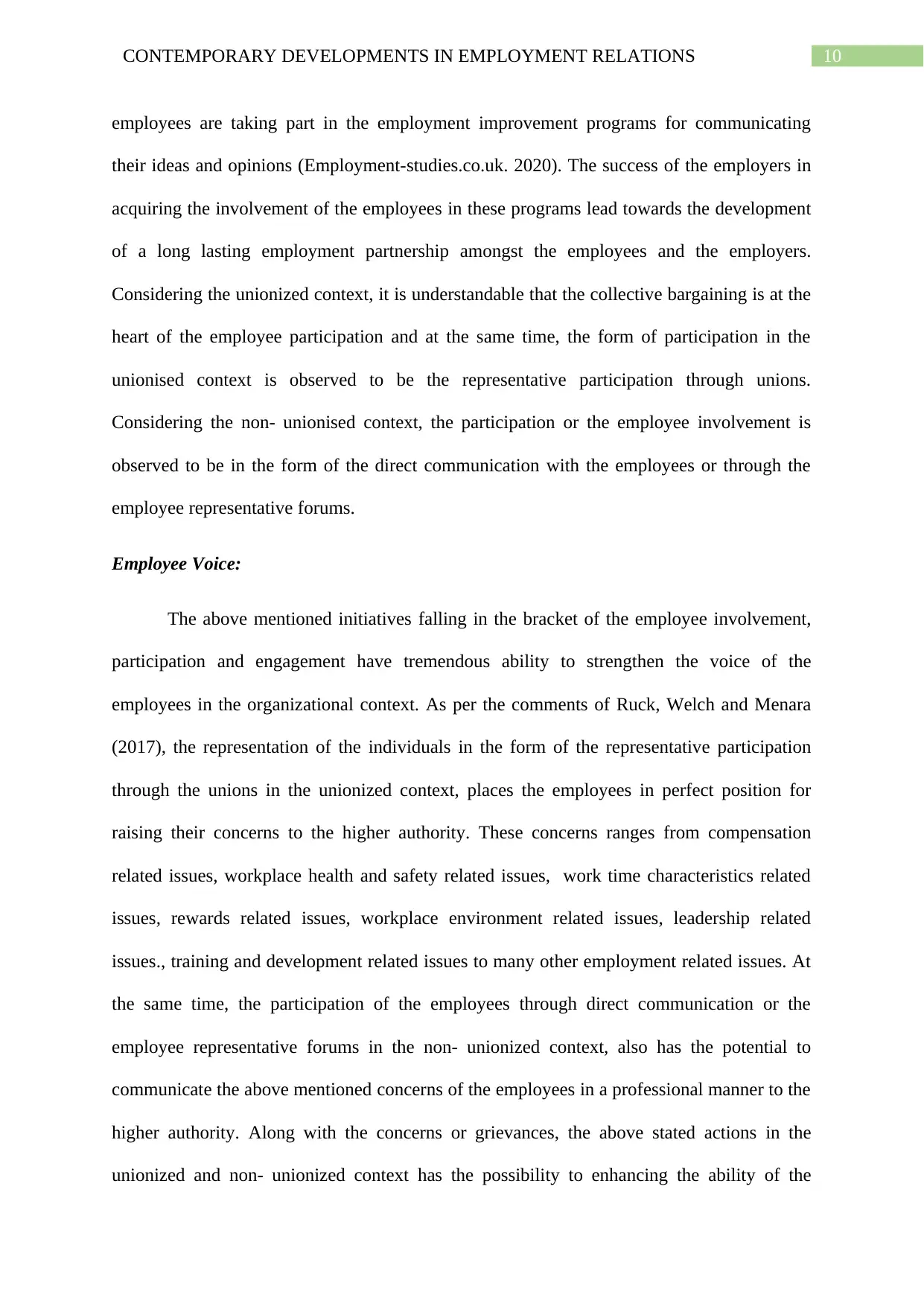
10CONTEMPORARY DEVELOPMENTS IN EMPLOYMENT RELATIONS
employees are taking part in the employment improvement programs for communicating
their ideas and opinions (Employment-studies.co.uk. 2020). The success of the employers in
acquiring the involvement of the employees in these programs lead towards the development
of a long lasting employment partnership amongst the employees and the employers.
Considering the unionized context, it is understandable that the collective bargaining is at the
heart of the employee participation and at the same time, the form of participation in the
unionised context is observed to be the representative participation through unions.
Considering the non- unionised context, the participation or the employee involvement is
observed to be in the form of the direct communication with the employees or through the
employee representative forums.
Employee Voice:
The above mentioned initiatives falling in the bracket of the employee involvement,
participation and engagement have tremendous ability to strengthen the voice of the
employees in the organizational context. As per the comments of Ruck, Welch and Menara
(2017), the representation of the individuals in the form of the representative participation
through the unions in the unionized context, places the employees in perfect position for
raising their concerns to the higher authority. These concerns ranges from compensation
related issues, workplace health and safety related issues, work time characteristics related
issues, rewards related issues, workplace environment related issues, leadership related
issues., training and development related issues to many other employment related issues. At
the same time, the participation of the employees through direct communication or the
employee representative forums in the non- unionized context, also has the potential to
communicate the above mentioned concerns of the employees in a professional manner to the
higher authority. Along with the concerns or grievances, the above stated actions in the
unionized and non- unionized context has the possibility to enhancing the ability of the
employees are taking part in the employment improvement programs for communicating
their ideas and opinions (Employment-studies.co.uk. 2020). The success of the employers in
acquiring the involvement of the employees in these programs lead towards the development
of a long lasting employment partnership amongst the employees and the employers.
Considering the unionized context, it is understandable that the collective bargaining is at the
heart of the employee participation and at the same time, the form of participation in the
unionised context is observed to be the representative participation through unions.
Considering the non- unionised context, the participation or the employee involvement is
observed to be in the form of the direct communication with the employees or through the
employee representative forums.
Employee Voice:
The above mentioned initiatives falling in the bracket of the employee involvement,
participation and engagement have tremendous ability to strengthen the voice of the
employees in the organizational context. As per the comments of Ruck, Welch and Menara
(2017), the representation of the individuals in the form of the representative participation
through the unions in the unionized context, places the employees in perfect position for
raising their concerns to the higher authority. These concerns ranges from compensation
related issues, workplace health and safety related issues, work time characteristics related
issues, rewards related issues, workplace environment related issues, leadership related
issues., training and development related issues to many other employment related issues. At
the same time, the participation of the employees through direct communication or the
employee representative forums in the non- unionized context, also has the potential to
communicate the above mentioned concerns of the employees in a professional manner to the
higher authority. Along with the concerns or grievances, the above stated actions in the
unionized and non- unionized context has the possibility to enhancing the ability of the
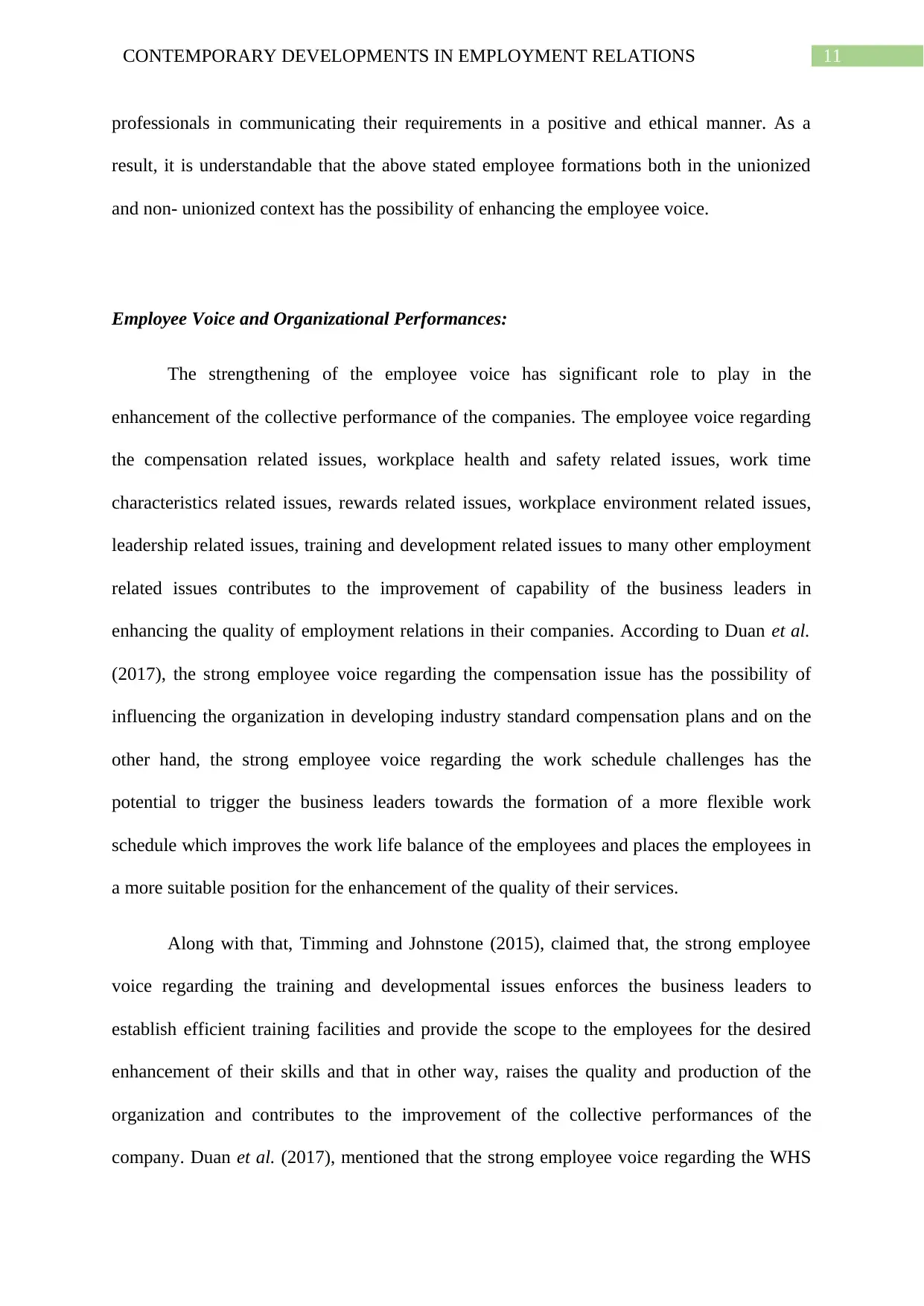
11CONTEMPORARY DEVELOPMENTS IN EMPLOYMENT RELATIONS
professionals in communicating their requirements in a positive and ethical manner. As a
result, it is understandable that the above stated employee formations both in the unionized
and non- unionized context has the possibility of enhancing the employee voice.
Employee Voice and Organizational Performances:
The strengthening of the employee voice has significant role to play in the
enhancement of the collective performance of the companies. The employee voice regarding
the compensation related issues, workplace health and safety related issues, work time
characteristics related issues, rewards related issues, workplace environment related issues,
leadership related issues, training and development related issues to many other employment
related issues contributes to the improvement of capability of the business leaders in
enhancing the quality of employment relations in their companies. According to Duan et al.
(2017), the strong employee voice regarding the compensation issue has the possibility of
influencing the organization in developing industry standard compensation plans and on the
other hand, the strong employee voice regarding the work schedule challenges has the
potential to trigger the business leaders towards the formation of a more flexible work
schedule which improves the work life balance of the employees and places the employees in
a more suitable position for the enhancement of the quality of their services.
Along with that, Timming and Johnstone (2015), claimed that, the strong employee
voice regarding the training and developmental issues enforces the business leaders to
establish efficient training facilities and provide the scope to the employees for the desired
enhancement of their skills and that in other way, raises the quality and production of the
organization and contributes to the improvement of the collective performances of the
company. Duan et al. (2017), mentioned that the strong employee voice regarding the WHS
professionals in communicating their requirements in a positive and ethical manner. As a
result, it is understandable that the above stated employee formations both in the unionized
and non- unionized context has the possibility of enhancing the employee voice.
Employee Voice and Organizational Performances:
The strengthening of the employee voice has significant role to play in the
enhancement of the collective performance of the companies. The employee voice regarding
the compensation related issues, workplace health and safety related issues, work time
characteristics related issues, rewards related issues, workplace environment related issues,
leadership related issues, training and development related issues to many other employment
related issues contributes to the improvement of capability of the business leaders in
enhancing the quality of employment relations in their companies. According to Duan et al.
(2017), the strong employee voice regarding the compensation issue has the possibility of
influencing the organization in developing industry standard compensation plans and on the
other hand, the strong employee voice regarding the work schedule challenges has the
potential to trigger the business leaders towards the formation of a more flexible work
schedule which improves the work life balance of the employees and places the employees in
a more suitable position for the enhancement of the quality of their services.
Along with that, Timming and Johnstone (2015), claimed that, the strong employee
voice regarding the training and developmental issues enforces the business leaders to
establish efficient training facilities and provide the scope to the employees for the desired
enhancement of their skills and that in other way, raises the quality and production of the
organization and contributes to the improvement of the collective performances of the
company. Duan et al. (2017), mentioned that the strong employee voice regarding the WHS
⊘ This is a preview!⊘
Do you want full access?
Subscribe today to unlock all pages.

Trusted by 1+ million students worldwide
1 out of 20
Related Documents
Your All-in-One AI-Powered Toolkit for Academic Success.
+13062052269
info@desklib.com
Available 24*7 on WhatsApp / Email
![[object Object]](/_next/static/media/star-bottom.7253800d.svg)
Unlock your academic potential
Copyright © 2020–2025 A2Z Services. All Rights Reserved. Developed and managed by ZUCOL.




